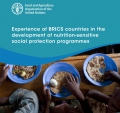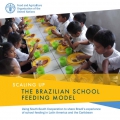Documents
Experience of BRICS countries in the development of nutrition-sensitive social protection programmes

14 Mar 2017
BRICS countries (Brazil, Russian Federation, India, China and South Africa) have taken the lead in recent global policy dialogues on economic, social and environmental issues. They are home to 3.1 billion people, representing 42 percent of the world’s population. Combined, BRICS have achieved the Millennium Development Goal of halving the prevalence of undernourishment by 2015. Building on their experience in reducing hunger, BRICS countries have also been instrumental in initiating mechanisms of South-South cooperation by supporting and promoting the establishment of nutrition-sensitive social protection systems in other developing countries. 
09 Mar 2017
South-South Cooperation (SSC) is playing a greater role than ever before in the development cooperation landscape. Innovation in the global South is generating new tools and partnerships for tackling issues of food insecurity, poverty reduction and sustainable agriculture. The South offers wide-ranging development solutions – knowledge, experiences and good practices, innovative policies, technology, know-how, and resources – that have proven costeffective and have huge potential to be shared, adapted and adopted.
The strategy is a response to growing demand from member countries to benefit from experiences of other Southern countries. It was adopted in 2013 after extensive consultations with national governments,...
08 Mar 2016
La coopération Sud-Sud (CSS) est un mécanisme avantageux grâce auquel on peut développer les capacités dans les pays du Sud par le partage des connaissances et ressources. À l’heure où la demande mondiale en matière de Coopération Sud-Sud et de Coopération Triangulaire a atteint un niveau sans précédent, la stratégie de la FAO vise à faciliter l’adoption d’un large éventail de solutions de développement visant la sécurité alimentaire, la réduction de la pauvreté et l’agriculture durable dans le cadre de la CSS.
17 Sep 2015
L’efficacité de la coopération Sud-Sud et triangulaire en tant qu’instruments pour catalyser le développement agricole fait l’objet d’un consensus grandissant. Il est généralement admis que la Coopération Sud-Sud (CSS) est un modèle de coopération pour le développement qui complète le modèle traditionnel de coopération Nord-Sud, et permet de surmonter des défis communs et de parvenir à la sécurité alimentaire, de réduire la pauvreté et de gérer durablement les ressources naturelles.
15 Jun 2015
Brazil has made tremendous progress in reducing malnutrition. In 1990, 14.8 percent of the population suffered from hunger; the figure is now just 1.7 percent. This remarkable transformation owes much to the country’s school feeding programme. By 2014, the programme was supplying approximately 43 million pupils with one or more servings of food per day, in almost 250 000 schools across the country. By Brazilian law, at least 30 percent of the food must be sourced from family farms, thus providing significant benefits to over 120 000 rural families. 